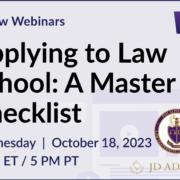Find The Perfect Time To Take The LSAT
Find The Perfect Time To Take The LSAT
Are you wondering when to take the LSAT and how to map out your study timeline? In this section, we tell you when the LSAT is offered and when we recommend that you take it.
Find The Perfect Time To Take The LSAT
When is the LSAT offered?
In the 2019-2020 year, the LSAT will be offered nine times.
The test dates are in: January, February, March, April, June, July, September, October, and November.
For a full list of test dates, check the LSAC website.
When should I take the LSAT?
There are three rules I suggest all applicants follow when determining when to take the LSAT.
Rule #1: Take the LSAT when you have time to study for it.
This rule might sound simple enough but many people don’t plan out when is actually the best time for them to take the exam. There are school, work, personal, and familial obligations that all need to be balanced alongside studying.
You must study for the LSAT even though there is no substantive material on it. Studying for the LSAT involves endurance building (it is a 3+ hour exam after all) and strategy to know how to quickly and successfully dissect complicated problems. You should not sit for the LSAT without having studied just to “try it out” and see how you do. That is what practice exams are for. (If you’re looking for an exam to take, check out the free LSAT exam offered on LSAC’s website.)
Most applicants study at least for a few months before taking the exam. You can study independently, take courses or use private tutoring. (Our LSAT tutors scored in the 99th percentile on the LSAT and have worked with students who were accepted into top law schools in the country, including Stanford, University of Chicago and Michigan.) But, irrespective of how you choose to study, sign up for an LSAT exam when you have time in your schedule to commit to studying for it.
Rule #2: Make sure you take the LSAT about 2 years before you plan to enroll in law school.
Deciding when to take the LSAT requires working backwards and mapping out your application process in advance. Generally, you apply to law school the year before you will actually enroll. This means that you should take the LSAT about 2 years before you plan to enroll.
If you are an undergraduate student and plan to enter law school immediately after graduation, then you should take your LSAT sometime in your junior year. You will apply for law school in the fall of your senior year. And, you will enter law school the following fall.
If you are still in school, don’t take the exam too early. Thinking about the LSAT in your freshman or sophomore year will distract you from excelling in your undergraduate program. Give yourself the time to adjust to the new demands of your undergraduate program before adding an additional worry to your plate. (Remember your GPA is an important factor in the admissions process and you don’t want your grades to slip.)
If you are a working professional, sign up to take the exam when you have a slow period at work and can commit your evenings and weekends to study. Since most of your days will be tied up in your current job and possible family obligations, give yourself even more time to study and prepare for the exam than the average college student might take. The same rules apply, however, and you should start studying for the exam about 2-3 years before you plan to enroll and take the exam at the 1.5-2 year mark.
Note that you can use your score for five years. Therefore, you have the flexibility for when you take the LSAT in the years prior to applying to law school. While you can take the exam early, you can severely hinder your chances of admission by taking the exam too late.
Rule #3: Always build in time to take a second exam, just in case.
Though we all hope you get a 180 the first time you take the LSAT, it doesn’t always happen that way for most people. Therefore build in a second tentative test date that you can take and still have your applications submitted on time. This is true whether you are aiming for an early decision deadline in the fall or just trying to make a final deadline in the spring.
For example, if a school’s early decision deadline is November 15 then taking the October LSAT for the first time and doesn’t give you the opportunity to take it again before that deadline in the event that you didn’t perform as well as you hoped. In this instance, a student should take the LSAT for the first time no later than September of that year. Then, you can have the October test date as a backup. (An LSAT exam in the winter or spring would be perfect timing.) Likewise, if applications close on May 1, do not wait to take the exam for the first time in April.
It takes approximately 3 weeks to receive your score after the test date. Always give yourself time to take the exam a second time. If you are happy with your first score then you can spend the time otherwise devoted to studying for the LSAT again to polishing your application documents.








Leave a Reply
Want to join the discussion?Feel free to contribute!